Fahlman B.D. Materials Chemistry
Подождите немного. Документ загружается.

(i.e., 0.1 ppb–0.1 ppm) and ability to detect/quantify any element in the Periodic
Table. In contrast to common bulk MS methods such as matrix-assisted laser
desorption/ionization (MALDI)
[103]
and electrospray ionization (ESI),
[104]
SIMS
analyzes samples in their native state without the need for a suitable matrix solution.
As a result, SIMS is the best choice to characterize organic-based thin films and
polymer surfaces.
The operating principle of SIMS is not unlike other techniques in this section;
that is, a high-energy (1–30 keV) ion source is directed onto a sample surface.
However, the absorption of this energy by the top ca.50A
˚
of the sample results in
the sputtering of neutral and charged (þ/) species from the surface.
[105]
These
ejected species primarily include neutral atoms and atomic clusters; however,
charged molecular fragments are also releas ed from the surface. Analogous to a
traditional mass spectrometer, SIMS analyzes these secondary ions based on their
relative mass/charge (m/z) ratios (Figure 7.44).
Depending on the desired species to be analyzed, a variety of primary ion
beams may be used such as Cs
þ
,O
þ
2
,O,Ar
þ
, and Ga
þ
. Whereas a cationic primary
beam such as Cs
þ
is used to ionize electronegative elements (e.g., O, C, N, chalco-
gens, halogens, etc.), oxygen atoms are used to ionize electropositive elements
(e.g., Li, Mg, Na, B, Al, etc.). Liquid metal ion beams (e.g., Ga, Au/Ge) are used
for high-resolution studies, since the beam may be focused to a smaller diameter
(<50 nm) for micron and nanoscale analyses.
There are two varieties of SIMS – static and dynamic. Static SIMS (often referred
to as time-of-flight SIMS, TOF-SIMS) is often the method-of-choice, used for
elemental analysis and imaging of the top two to three monolayers of a sample; in
comparison, dynamic SIMS is used to determine elemental concentrations of the
sample, as a function of depth. As such, dynamic SIMS is a destructive technique
primarily used for depth profiling, whereas TOF-SIMS does not appreciably deteri-
orate the surface being analyzed. For instance, due to a slow, controllable sputtering
rate, the entire analysis may be performed without removing less than one-tenths of
an atomic monolayer.
It should be noted that any SIMS analysis will at least result in surface roughness/
cratering and elemental mixing within the outermost monolayers. When the primary
beam interacts with surface atoms, the incident energy is transferred to target atoms
through a series of binary collisions. Some atoms/fragments receive sufficient
energy to be recoiled through the sample surface and are removed from the material.
However, other less noticeable effects will result such as the implanting of primary
ions, and mixing with sample atoms at depths of 10 nm below the surface. The
magnitude of these effects is governed by the incident beam,
[106]
as well as the
crystallinity and surface defects of the sample.
Dynamic SIMS typical ly uses a quadrupole mass analyzer; however, a TOF mass
analyzer offers much higher sensitivities (with limitations, vide infra) and mass
ranges. In a TOF-SIMS, an ion of known electrical charge, but unknown mass,
is accelerated by an electrical field. As a result, all ions of the same charge will
have identical kinetic energies. However, the velocity of the ion will depend on the
638 7 Materials Characterization
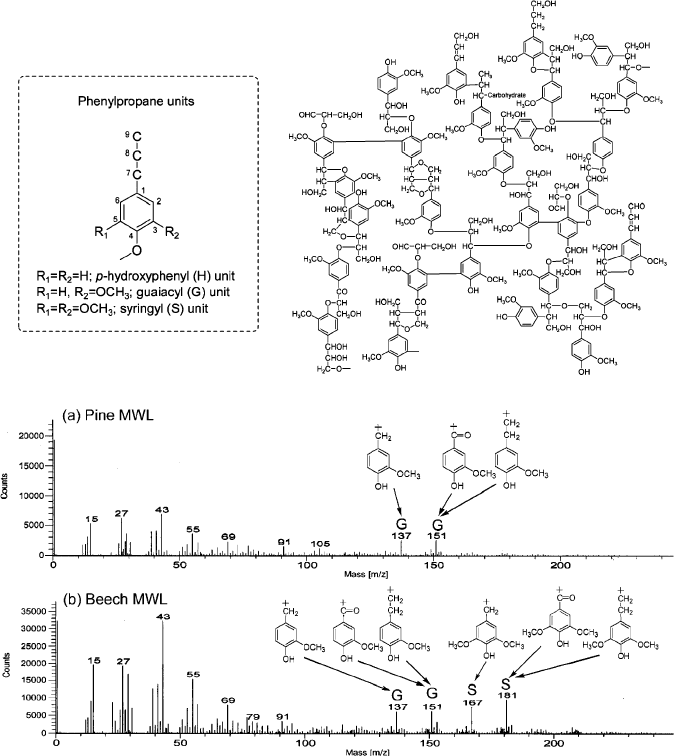
mass/charge ratio, which affects the time it takes for the char ged species to reach the
detector. That is, light ions will reach the detector befor e heavier species, allowing
for effective mass separation and analysis. It should be noted that each pulse of the
primary ion beam produces a full spectrum of secondary ions. Hence, the highest
Figure 7.44. SIMS analysis of lignin, the second most abundant biopolymer in nature, following
cellulose. Shown is the phenylpropane subunits and a structural model of softwood lignin (top). The
secondary-ion mass spectra of pine (softwood) and beech (hardwood) milled wood lignin (MWL, a
solvent-extracted form of lignin from beech wood) are also shown (bottom). Reproduced with permission
from Saito, K.; Kato, T.; Tsuji, Y.; Fukushima, K. Biomacromolecules 2005, 6, 678. Copyright 2005
American Chemical Society.
7.3. Surface Characterization Techniques 639
mass resolution is afforded by using the shortest pulse of the primary ion beam, since
the time-of-flight for ions may be determined more precisely.
The sputtering event will yield secondary ions with a range of kinetic energies.
Whereas atoms will contain their kinetic energy only in translational modes, charged
molecular fragments will have the kinetic energy spread over translational, vibra-
tional and rot ational modes. By varying the accelerating voltage of the electrostatic
ion energy analyzer, one is able to select secondary ions (e.g., monoatomic vs.
multiatomic (molecular fragments)) based solely on their translational energies. For
instance, ions with a lower energy are deflected at larger angles, which prevents
them from passing through to the mass analyzer.
Due to more energetic collisions, an incident beams consisting of either heavier
ions (e.g., Au
þ
vs.Ga
þ
), or polyatomic species (e.g., C
60
þ
,
[107]
Au
3
þ
,SF
5
þ
,Bi
3
þ
),
will result in much greater secondary ion yields for high molecular components –
especially in the range of 500–5,000 Da. For instance, the use of an atomic cluster
such as C
60
þ
results in a significant number of surface atoms being sputtered from
the surface, relative to a smaller beam such as Ga
þ
(Figure 7.45). For a 15 keV
incident beam, each carbon atom would contain 15,000/60 eV (i.e., 24,000 kJ mol
1
,
or 50 times greater than the C—C bond strength in C
60
!). Hence, the atomic cluster
likely behaves as 60 individual 250 eV atoms with a much broader impact on the
surface. However, since the kinetic energy of each C
60
cluster is much less than a
Ga
þ
ion (15 keV), the sputtering event for C
60
þ
is limited to the first few monolayers
of the sample.
[108]
Another strategy that is used to increase the TOF-SIMS signal for polymeric
samples is the application of a metallic coating
[109]
or nanoparticles
[110]
onto the
sample surface (Figure 7.46). The signal enhancement is likely a result of facilitated
electron loss (Eq. 12), as well as the formation of conjugate ions that contain the
neutral polymer fragment and metal atoms (Eqs. 13 and 14). The reaction between
the polymer fragment and a proton, either in the gas-phase or at the metallic surface,
may also result in signal enhancement (Eq. 15):
M ! M½
þ
þe
ð12Þ
M þ Me½
þ
! M½
þ
+Me
0
ð13Þ
M þ Me½
þ
! M þ Me½
þ
ð14Þ
M þ H
þ
! M þ H½
þ
ð15Þ
where M is the neutral polymer fragment; Me, neutral metal atom (present as a film
or nanoparticles).
In addition to secondary ion generation, SIMS also results in the releas e of
secondary electrons near the sample surface. As previously discussed for SEM
analysis, this may result in the buildup of a net electric current for nonconductive
surfaces. Analogous to microscopy applications, such surface charging will diffuse
the primary beam, making it difficult to perform microanalysis using SIMS. Fur-
thermore, charging will deleteriously affect the detection of secondary ions, by
640 7 Materials Characterization
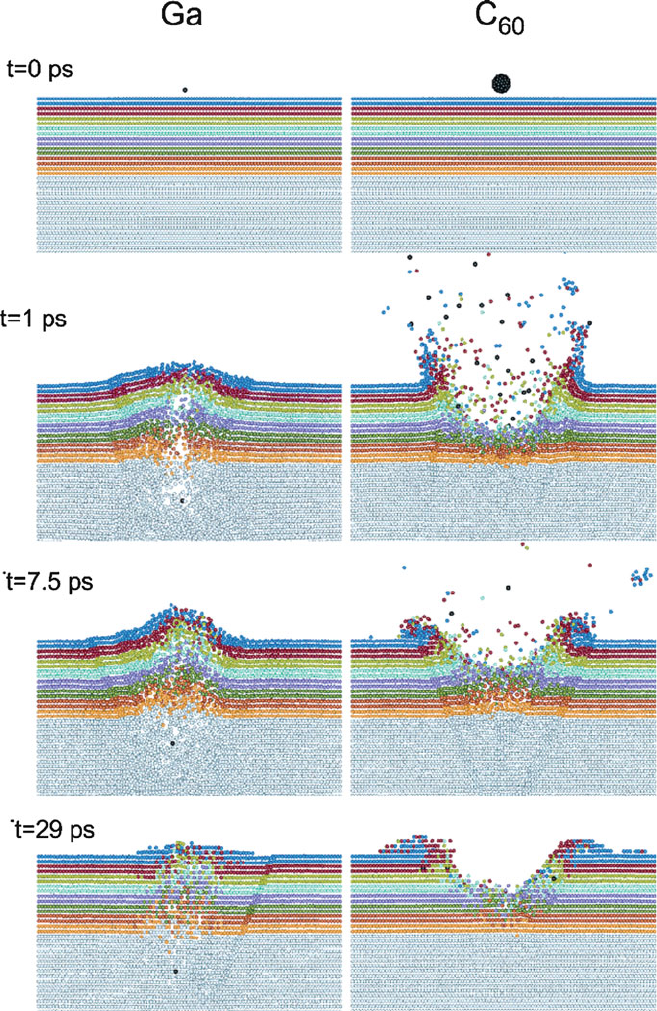
Figure 7.45. Molecular dynamics simulation of the ion bombardment of a Ag crystal surface with a
15 keV Ga
þ
beam, and a 15 keV C
60
atomic cluster beam. The C
60
beam results in a larger crater and more
material removed from the surface. In contrast, the Ga
þ
beam results in a destructive effect at greater
sample depths, without successful sputtering of the sample. Reproduced with permission from Winograd,
N. Anal. Chem. 2005, 77, 142A. Copyright 2005 American Chemical Society.
7.3. Surface Characterization Techniques 641
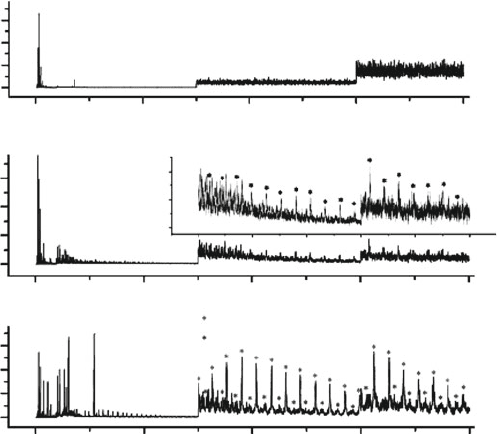
altering the energy distribution of the recoiled ions . These effects are magnifie d
when a sample contains a dielectric surface and a conductive substrate. Due to the
strong induced electric field, mobile metal ions in the substrate may migrate toward
the surface. Consequently, the data obtained from depth profiling will no longer
reflect the original composition of the sample layers. Since information is gleamed
from the uppermost portion of the sample, the application of a simple conductive
coating is not feasible for SIMS. Rather, the effects of charging may be minimized
by the following techniques:
(i) Electron bombardment – typically used in quadrupole (dynamic) SIMS instru-
ments. A low electron beam is used to compensate for a positive charge
buildup.
(ii) Surface conducting grid – a metallic grid is placed over the sample. When
the primary beam impinges this surface, the grid releases secondary electrons
that dissipate the buildup of positive charge. Alternatively, a gold or carbon
coating may be sputtered onto the sample surface, and then removed from the
area to be analyzed – leaving a conductive film that encapsulates the area
of interest.
(iii) Use of negative primary ion beams – for example, oxygen.
a
b
c
Untreated Tentagel
Tentagel-Au
Tentagel-Ag
x10 x300
x1000
0 1000 2000 3000 4000
0 1000 2000 3000 4000
0 1000 2000 3000 4000
1.5
1.0
0.5
0.0
1.5
1.0
0.5
0.0
1.5
1.0
0.5
0.0
0.4
0.2
0.0
[((CH
2
)
2
O)
40
AuOCH
3
+(C
5
H
4
O(CH
2
)
2
)+H)
n
]
[((CH
2
)
2
O)
20
AgO+(C
6
H
4
(CH
2
)
2
O
2
H)
n
]
[((CH
2
)
2
O)
2u
AgNaHO
2
(CH
2
)
2
+(C
6
H
4
O(CH
2
)
2
O
2
H)
n
]
m/z
Intensity (Counts) x 10
5
Figure 7.46. SIMS signal enhancement from metal nanoparticle deposition. Shown are comparative
spectra in the high molecular weight range for an untreated polymer (a), along with nanoparticle-
treated samples (b, c). Reproduced with permission from Marcus, A.; Winograd, N. Anal. Chem. 2006,
78, 141. Copyright 2006 American Chemical Society.
642 7 Materials Characterization
Another widely used application for SIMS is ion imaging, which shows secondary
ion intensities as a function of spatial location on the sample surface (Figure 7.47,
top). Further, if imaging is performed in tandem with depth profiling, a three-
dimensional compositional map of a sample may also be generated (Figure 7.47,
bottom). Two modes of imaging via SIMS are possible:
(i) Ion microscopy – the sample is uniformly irradiated and the image is formed
directly on a viewing screen via optics similar to SEM (max. lateral resolution
of ca. 0.5 mm).
(ii) Ion microprobe – the ion beam is rastered across the surface (max. lateral
resolution of ca. 20 nm, using liquid metal ion guns).
7.3.4. Atom-Probe Tomography (APT)
Atom-probe microscopy/tomography is based on field-ion microscopy (FIM), pio-
neered by Muller in the late 1950s to image the arrangement of atoms at the surface
of a sample. In this technique, a sample is sharpened to a tip of radius <50 nm via
electropolishing,
[113]
FIB,
[114]
etc. The sample tip is then placed into a UHV cham-
ber, cooled to a temperature of ca. 20–100 K, and a given a positive voltage (15–65 V
nm
1
). The chamber is then backfilled with an imaging gas such as He or Ne. Field
ionization of the imaging gas atoms occurs via quantum mechanical tunneling of
the outermost valence electrons of He/Ne into atoms within the sharply pointed tip.
The generated He
þ
/Ne
þ
ions are then repelled from the positively-charged ions of the
nanotip sample and are accelerated toward a negatively-charged multichannel plate
(MCP) detector. Unlike conventional (electron, light) microscopy, FIM is a lens-less
technique that operates via point projection. Accordingly, the resolution is not wave-
length-limited and is able to easily reach >2 10
6
X, which is related to the ratio of
the tip-to-MCP distance and curvature of the sample microtip.
If the positive charge applied to the sample nanotip is increased, it is possible
to field evaporate sample atoms from the tip as positivel y-charged ions. Field
evaporation may be induced by high-voltage pulsing or pico-/femtosecond laser
pulsing. Hence, FIM allows one to this technique allows one to etch away sample
atoms one at a time, with positional information. However, if one also includes a
time-of-flight (TOF) mass spectrometer, the m/n ratios of individual ions may also
be determined, which combines the features of high-resolution TEM (atomic reso-
lution) and secondary ion mass spectrometry (elemental analysis). The combination
of these capabilities is referred to as atom-probe field ion microscopy (APFIM),
or simply atom-probe microscopy (APM). Since the positional information may
be reconstructed into a 3-D map of the sample, this technique is also referred to as
atom-probe tomography (APT).
[115]
Figure 7.48 illus trates the most common type of
APT, known as loca l-electrode atom-probe (LEAP) tomography.
[116]
The power of
this new techniqu e is amazing; to illustrate one of the many exciting precedents,
Figure 7.49 shows the spatial positions of individual Ge atoms and P dopants within
a single Ge nanowire!
[117]
7.3. Surface Characterization Techniques 643
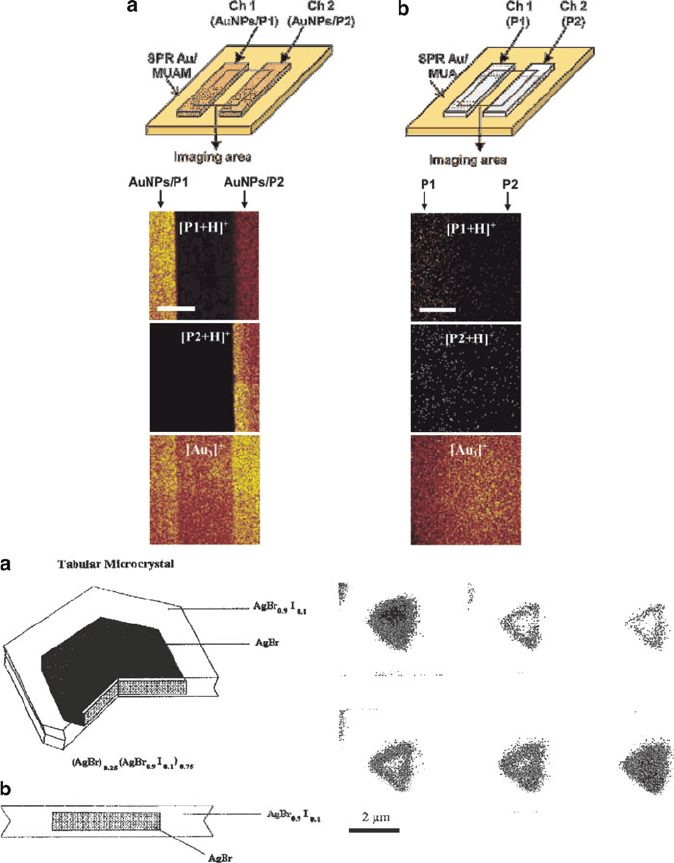
Figure 7.47. Ion imaging using SIMS. (Top) Positive TOF-SIMS images of fragments from peptides
(P1, Ac-PRNYVTP-NH
2
; P2, Ac-PRNYpVTP-NH
2
) patterned on SAMs, pretreated (a) with gold
nanoparticles and (b) without gold nanoparticles. The lateral region at both sides (both arrows) represents
a microfluidic pattern of different peptides (P1 and P2). TOF-SIMS utilized a Au
þ
primary ion gun, with an
ion dose <10
13
ions cm
2
at a sample area of 300 300 mm
2
. The scale bar is 100 m m.
[111]
(Bottom)
Schematic of a silver halide microcrystal with a core-shell structure. The diameter is ca.0.5–2mm; the
thickness is ca. 150–400 nm. To the right of the illustration are successive I
ion images (using a Cs
þ
primary beam) for the crystal, shown from the top left corner to the bottom right corner, as a function of
depth profiling. Whereas the first and last images show a homogeneous iodine-rich array, the middle images
show the I
distribution localized in the shell of the microcrystal.
[112]
644 7 Materials Characterization
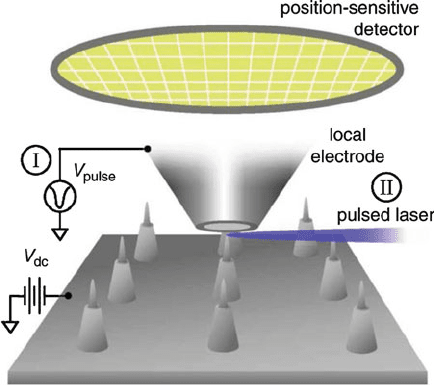
7.4. SCANNING PROBE MICROSCOPY (SPM)
The characterization techniques discussed thus far have involved the interaction of
an incident beam of radiation (electrons, X-rays, ions, or light) with a sample.
Subsequent scattering, transmission, and/or secondary emission is then used to
provide an image of the sample, or delineate its chemical composition. This section
will discuss a technique that does not involve irradiation, but rather features the
scanning of a probe across a surface (hence, terme d SPM). A tangible analogy of this
technique is actually the precursor to modern CD players – the phonograph/record
player (check your local antique shop if you have not seen one before!). The heart of
an antiquated phonograph is a cantilever-supported stylus that followed the grooves
on the record. The mechanical movement of the stylus within the grooves resulted in
an electrical response from a piezoelectric crystal, which was then converted into
sound via the speaker system. Though this technology was abandoned for stereo
applications in the 1980s, SPM represents a next-generation application for a stylus
with a much sharper tip (radius of curvature of <50 nm), to follow the surface
topography of microscale and nanoscale materials. The resolution of SPM is among
Figure 7.48. Illustration of a local-electrode atom-probe (LEAP) tomograph employing either voltage,
I, or laser pulses, II. The substrate, whic h contains an array of microtip specimens, is maintained at a
positive potential, V
dc
; the substr ate can be translated in the x-y plane. The local electrode is pulsed with
a negative v oltage, V
pulse
, to increase the E-field at a m icrotip specimen to the requisite value for field
evaporat ing atoms as ions. Alter natively, a specimen is pulsed with femto- or picosec ond laser pulses at
a high repetition rate. A field-ion microscope (FIM) looks physically identical to a LEAP tomograph,
but it does not have a delay-line detector. The multichanne l plate is used to obtain a FIM image of the
atoms on the surface of a microtip employing helium or neon as an imaging gas. Thus, a LEAP
tomograph also can be used as a FIM. Reproduced with p ermission from Seidman, D. N.; Stiller, K.
MRS Bull. 2009, 34, 717. Cop yright 2009 Materials Research Society.
7.4. Scanning Probe Microscopy (SPM) 645
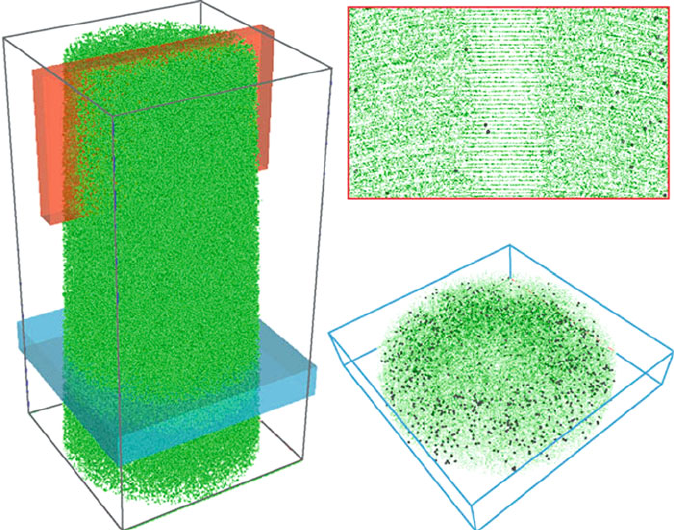
the best of all methods to date, with the possibility of atomic scale manipulation/
imaging (revisit Figure 6.7 – the manipulation and imaging of individual Xe atoms –
performed almost 20 years ago!).
[118]
Analogous to record players, a SPM tip is supported by a flexible cantilever.
During analysis, the tip is slowly rastered across the surface of a material – either a
few Angstroms away from the surface (noncontact mode), or in contact with the
sample (contact mode). There are two primary forms of SPM:
[119]
(i) Scanning tunneling microscopy (STM) – set the precedent for SPM in the early
1980s. The tip is held a few Angstroms from the sample surface during scans.
(ii) Atomic force microscopy (AFM) – the tip may interact with the sample surface
through either contact or noncontact modes.
Figure 7.49. Atom-by-atom mapping of a germanium nanowire by atom probe tomography. Left: 3-D
reconstruction of an individual Ge nanowire with each green sphere representing an individual Ge atom.
The dimensions are 50 50 100 nm
3
. The region enclosed by the red box is displayed at upper right,
with single atomic planes visible in the center of the image. The grey spheres are phosphorous dopant
atoms used to control the conductivity. (The dimensions are 5 25 15 nm
3
). The region enclosed by
the blue box is displayed in the lower right, revealing an inhomogeneous distribution of phosphorous
atoms. (The dimensions are 50 50 10 nm
3
). The ‘shell’ of enhanced doping results from surface
reactions during growth of the nanowire. Reproduced with permission from Nature Nanotechnol. 2009, 4,
315. Copyright 2009 Nature Publishing Group.
646 7 Materials Characterization
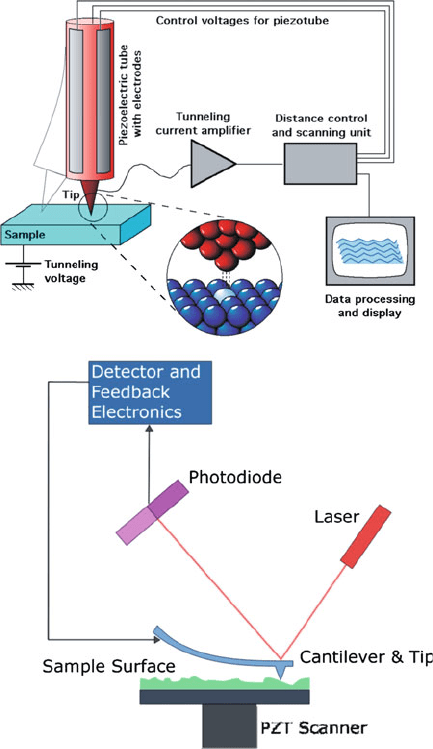
Both types of SPM are most often used to provide an image of the surface
topography. Though both techniques are frequently carried out under ambient
temperatures/pressures, or even in liquids,
[120]
they may also be performed in an
UHV chamber (ca.10
11
Torr)
[121]
in order to prevent sample contamination,
prevent oxidation of the surface, or monitor the deposition of sputtered thin films
in real time. As a STM tip is scanned across the sample, a quantum mechanical
tunneling current is established between the sample surface and a sharpened W
or Pt/Ir tip (Figure 7.50, top). The magnitude of the current is dependent on the
Figure 7.50. Illustrations of STM (top), and AFM (bottom). Reproduced with permission through the
Wikipedia Commons agreement. The illustration of STM is courtesy of Michael Schmid, TU Wien.
7.4. Scanning Probe Microscopy (SPM) 647
